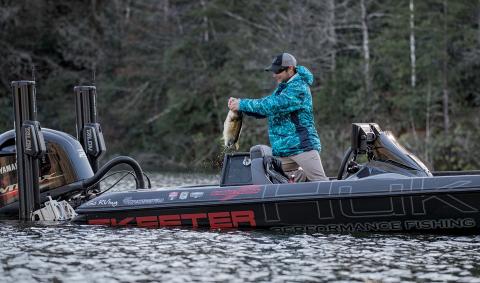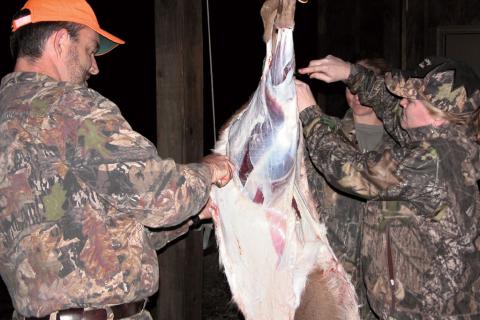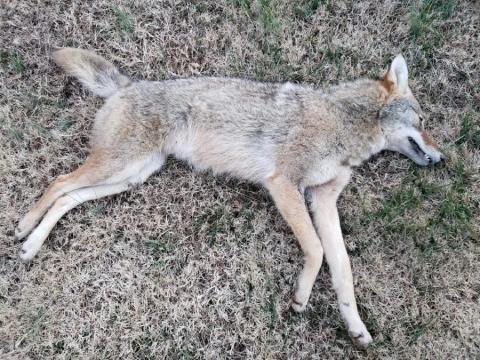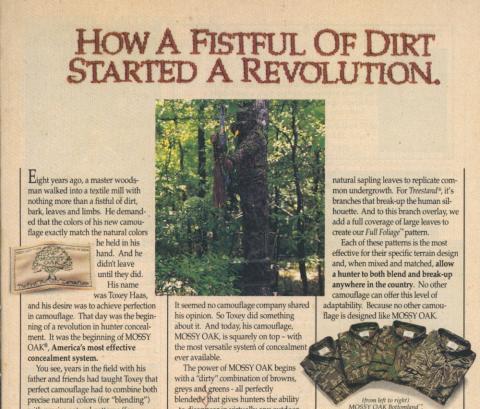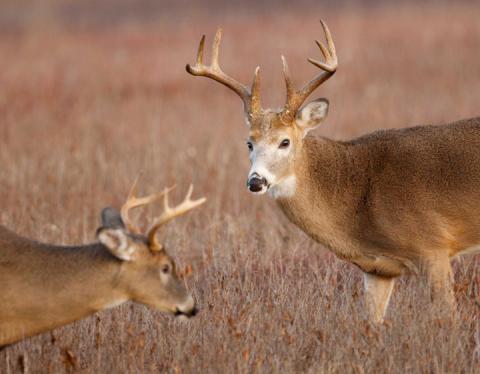Avid deer hunter, Nathan LaClaire of Schaghticoke, New York, has been a Mossy Oak ProStaffer for 6 months. However, Rachelle, his wife, has been on the ProStaff for 6 years.
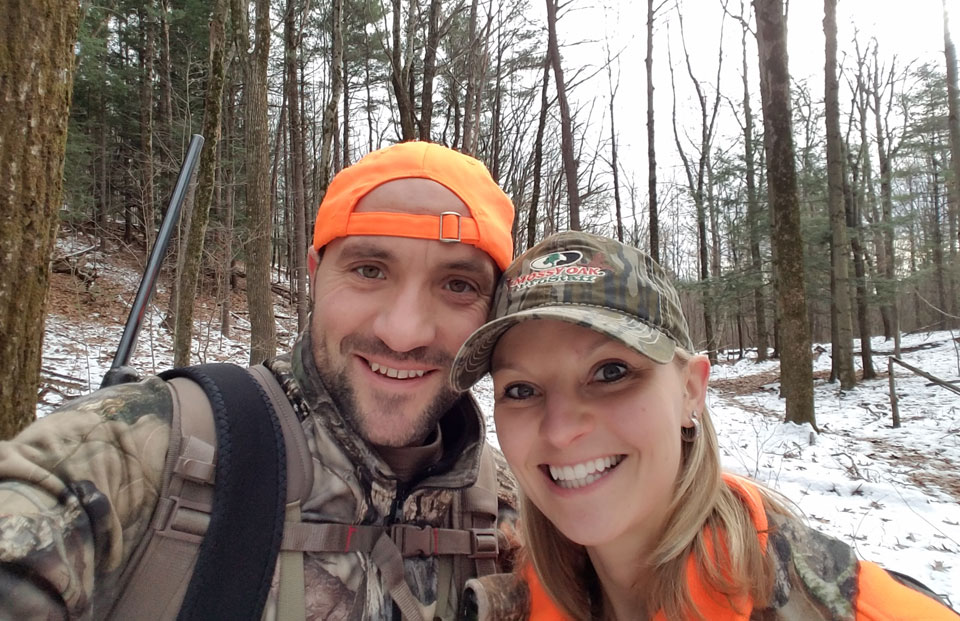
Being Ready to Take a New York Buck Deer
I was hunting in southern New York near Nassau County on about 40 acres of private land in early 2018. Forty acres is considered a big parcel of land in New York State. The property belongs to a friend of mine. His instructions to me were, “If you plan to mount the buck, then you can take him on my land.”
My stand was in the bottom of a draw, and I had the wind in my favor. What made this an unusual hunt and a lesson well learned was that I didn’t take this buck from my stand. I harvested him as I was walking into my stand. I learned from this hunt that if you put your stand in a place where you expect to see a buck, you also should expect to see the buck as you’re walking to your stand. I’d set up at a different place during the morning hunt. At 9 a.m., my friend and I took a tree stand and set it up where there were a number of scrapes. Although my friend had trail cameras out on this site, he hadn’t seen any bucks on them. He suggested that I go back to the stand we’d put up at about 11 a.m. My friend told me, “Nock your arrow, walk slowly and quietly to your stand, and be ready to take a shot before you arrive at your stand.”
I came over a small knob and spotted a doe about 25 yards from me once I started my walk. When I turned slowly, I saw the buck behind the doe about 27 yards away. Both deer spotted me when I came over the knob. The doe turned to run. As soon as the buck looked at the doe and saw her running off, he already had an arrow in his chest. Both deer barely saw me, and I had a hard time seeing them as my head came over the knob. As soon as I spotted them, I came to full draw and took one step forward to see and shoot clearly over the knob. I knew the deer was at about 27 yards because the tree where I’d hung my tree stand was directly behind him. After I’d hung the stand earlier, I’d ranged the trees all around the stand. I was pretty certain about the yardage.
I think ranging the trees around your stand and being able to identify those trees you’ve ranged when walking to your stand are important keys to remember when putting up a stand. As soon as I spotted the buck, I saw his left side main beam and instantly noticed that his G2 was about 10-12 inches long. Where I’m from, we don’t often see bucks with that size rack.
The arrow struck on the right hand side of the curl of hair on the buck’s chest, because the buck was looking straight at me. I don’t like to take a head-on shot, but I knew that was the only shot I’d get at him. I also knew the yardage and realized I could hit that type of a target. I saw my arrow go in with its Rocket/Trophy Ridge Hammerhead broadhead all the way up to the fletchings. As soon as my arrow hit, I saw blood begin pouring out. The buck ran into a thicket, started bouncing off of trees and fell into a small creek. I couldn’t see him, but I could hear him.
I backed out, called my friend and said, “Well, I don’t have to sit here all day. I just shot my buck.” My hunting buddy explained, “I told you that was a good spot to take a buck.” My friend was only 10 minutes away, and I waited by the road for him to arrive. I told him the story of the hunt and explained that I hadn’t seen the big buck fall but knew I had a good hit on him. We waited 15 minutes more and then took our time returning to my stand. We followed the buck’s blood trail and had no problem recovering my big 8-point buck that gross scored 136 points, a whopper buck for New York State.
Hunting Deer on 100 New York Acres
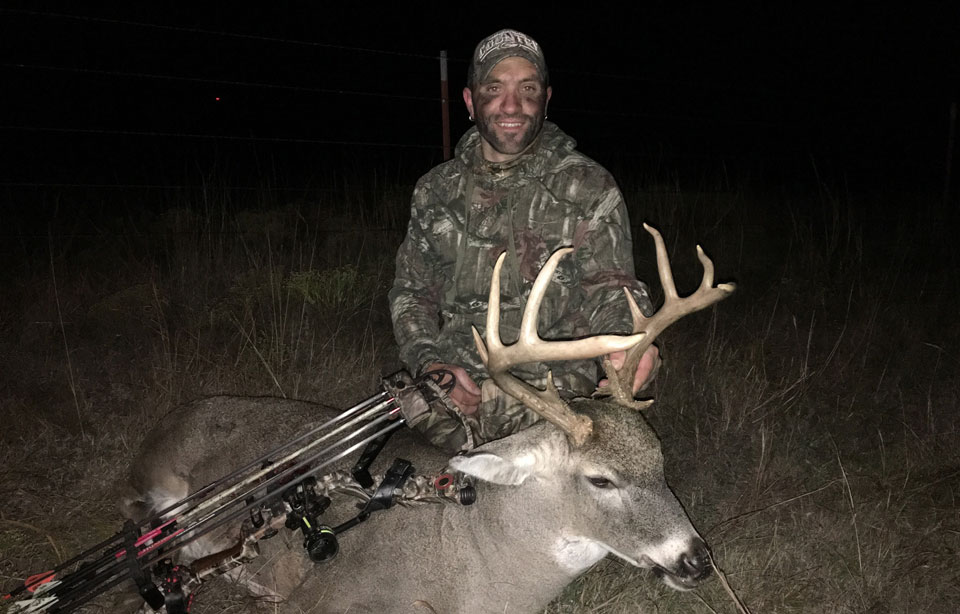
I try to hunt every day of New York’s deer season, even if I only have 30 minutes after work to climb into a tree stand. I love deer hunting that much. That 100 New York acres I have to hunt is composed of hardwoods and pines with a CRP field on top of a hill. This land belongs to my wife, Rachelle’s father. He’s hunted that property since he was a youngster. Although I hunt that property hard, I’ve only taken one doe off it. However, this year (2018), I’ve seen a couple of nice, 8-point bucks on a neighboring property that has food plots planted on it. The bucks seem to be bedding on that land and only show up on my 100 acres after dark.
Rachelle has taken a nice 6-pointer and 8-pointer off her dad’s property. She took the 6-pointer in 2017 and the 8-pointer in 2012. Rachelle hunts every chance she gets and is outside almost as much as me. However, we have youngsters at home, and they eat up a lot of her hunting time.
I’m often asked whether or not I ever use a deer decoy to hunt in New York. I’m afraid if I put up a decoy in New York that the decoy might spook every deer I see. New York doesn’t have enough mature deer to cause a buck to fight another buck. New York also has heavy hunting pressure and a really good buck may only be 3 years old.
Something that makes deer hunting in New York different from hunting in other sections of the country is that numbers of people live in New York State, and many of those deer hunt. On most small properties, you’ll have a number of people hunting the same ground. On public lands in New York, you may find two to three times as many people hunting the same property.
Why I Bow Hunt Deer
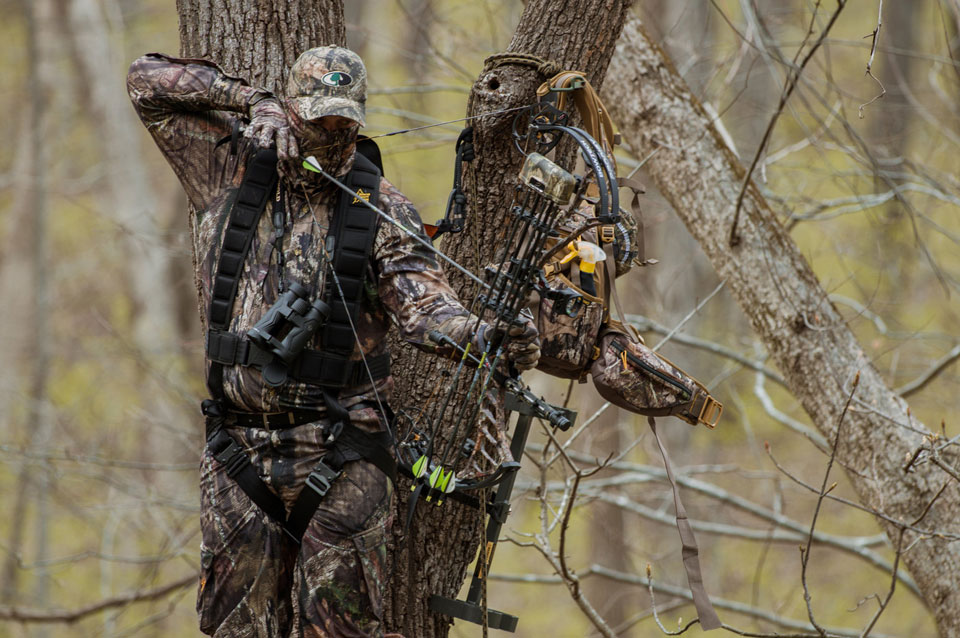
From as far back as I can remember, my dad has taken me bowhunting. I took my first deer with a bow when I was 15 years old, the legal age a New York hunter can begin to hunt with a bow. I went with my dad and set up my own tree stand, a ladder stand. The next morning, Dad drove me to my ladder stand and dropped me off. He then went about 200-yards away to his stand. He told me to stay on my stand until he returned. I didn’t see any deer that first morning. That evening, Dad decided not to hunt, but he took me to my ladder stand. He said, “I’ll come back after dark and pick you up on the four wheeler.”
As I was sitting on my stand, I spotted a spike buck that came walking in behind me at about 15 yards. Back then I didn’t use any sights, but instead just aimed down my arrow. I knew I’d made a bad shot and hit the deer in the gut instead of in the kill zone. Once I climbed out of my tree stand, I snapped a branch and heard the deer get up and run. But then I heard the buck fall. When my dad picked me up that night, I told him, “Dad, I know my arrow hit a spike in the gut. I want to wait until morning before we go and look for him.” I didn’t tell my dad I’d climbed out of my tree stand earlier.
The next morning, my dad, my uncle and myself went out to my tree stand and followed the blood trail. Instead of finding a spike, the buck was a 7-pointer. I yelled, “I shot a 7-pointer for my first bow kill. I thought he was a spike.” I think my dad was happier than I was.
I was shooting a Bear bow back then with fingers and sighting down my arrow. I had learned the technique because my dad and I bowfished a lot. Since we didn’t use any sights for bowfishing, that was the only way I knew to aim at a target with my bow. I felt confident hunting that way. However, once we got bow sights, I could tell those bow sights made a major difference in my shooting.
I’ve taken between 20-25 deer with my bow. I don’t know the exact number, but I always wanted to start a hunting journal and never have. So, I don’t have the information I need. About 10-11 of those deer were bucks. When I was younger, they were smaller bucks. However, the bucks I started harvesting once I grew older were in the 120-135 point range.
When I was younger, I was hunting near Stillwater, New York, where there were hardwoods, corn and CRP land. Back then I had about 400 acres I could hunt. That land was owned by the farmer who lived next to my parents’ house. My entire family, including uncles and friends, hunted that land. I also learned from my dad how to look for sign and set up and hunt with the correct wind. My dad always bought me ladder stands for hunting. I probably had five or six of those stands at one time. Our family generally took 6-10 deer per year, including a buck and does from this property. Because we all communicated with each other, we tried not to overhunt that land. Each of us had our own particular spot where we hunted. My place was right on the edge of a cornfield where a little draw went up behind the cornfield. Also plenty of acorns were in that hardwood draw. A fence line ran from the cornfield up the draw. That land was probably the most productive land I ever had to hunt.
Marrying a Bowhunter and Eating the Game We Take
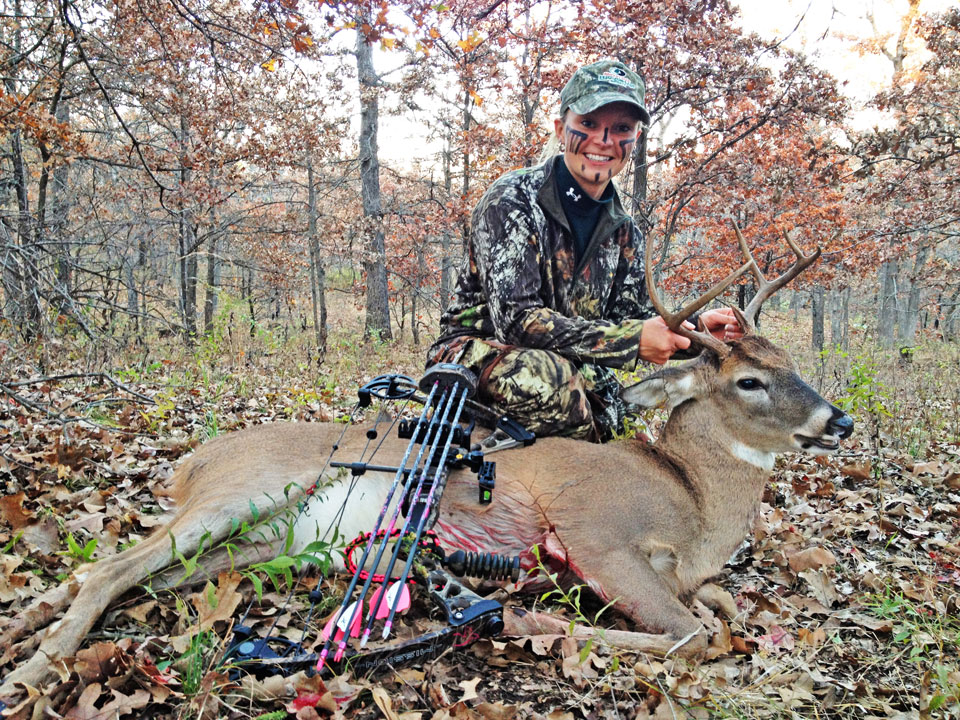
My wife, Rachelle, and I married in 2011. I met Rachelle at a party when we were in high school, and one of our first couple of dates was a bowhunting trip. Then when I met Rachelle’s dad, I learned quickly that Rachelle, her dad and her brother, Scott Yando, were heavy into bowhunting.
Although before we married, Rachelle had only taken 3-4 deer with her bow. Before long I figured out that she and her entire family were avid bowhunters. When we first started dating, we’d bowhunt together often. So, my hunting buddy became my sweetheart and then my wife. We now have two children, a 4-year-old named Colton, and a 2-year-old daughter, Skylar. We just bought Colton his first bow, a small Hoyt bow. Colton shoots quite a bit in the backyard with my wife, Rachelle. We started him off shooting arrows with the little stoppers (suction cups) on their ends. He shot that stopper bow and arrow set often, so we decided to go ahead and buy him a compound bow. Although he can’t quite pull that bow back yet, he goes out with his mom and continues to try to pull that bow back. He’s been to my deer stand with me a couple of times, and he goes with his mom and sits in a double ladder stand. Rachelle told me that he can sit still and be quiet for a 4-year-old.
Rachelle already had been a part of the Mossy Oak ProStaff, and she suggested me to Mike Monteleone, a regional manager for the Mossy Oak ProStaff. When I went to the Cabela’s in-store in Hamburg, New York, where there was a meeting of the ProStaff in that section of the country, Mossy Oak finally made it official. Although I’d hunted in Mossy Oak for most of my life, once I got on the Mossy Oak ProStaff I realized I had a new family. I had only talked to a couple of other ProStaffers before that meeting, but I really got to know them when I spent time with them.
The good news is even though I took that really nice buck with my bow during the early 2018 season, I’ll be able to harvest another buck deer with a gun. I shoot a Remington .30-06, and I’ve probably taken 10 deer with my rifle. I’m often asked what’s the difference in hunting with a bow and hunting with a rifle. I don’t think I have to put as much effort in to take a deer with a rifle, as I do taking a deer with a bow. In New York, you don’t have to scout as much to take a buck deer with a rifle as you do a bow. In other states, that statement may not be true.
Something else I like about bowhunting is that during bow season, the deer are much calmer. In rifle season, around where I live sounds like a war zone. The deer will jump and get spooked, if a squirrel even throws a pine cone out of a tree. The first deer I took with my rifle was a spike that came to within 15 yards of me. The longest shot I made with my rifle was about 150 yards.
Although Rachelle and I often don’t fill all the tags we have, Rachelle had rather shoot a doe for the freezer. I’m the same way. We try to fill our freezer with deer and wild game.
In 2015, I shot a 400-pound black bear that I saw while bowhunting. But I couldn’t get a shot off at him then. That bear winded me when I was on the ground, hanging a stand with my bow laying on the ground. He turned and ran. I was hunting with my brother-in-law Scott and heard a stick break. I whispered to Scott, “There’s a bear. Hand me my bow.” I retrieved my bow, and when I stood up to draw back, there was a big thicket between me and the bear. I told myself, “I’m not going to risk wounding a big animal like that by trying to shoot through that thicket.”
Three days later, rifle season opened. The bear came out to a cut cornfield, about 80-90 yards away. I was shooting free hand. I didn’t have a rest. My first shot hit him in the hindquarters. Once I saw the dust fly out of the bear’s coat, the bear started running toward me at an angle. When he got to about 50 yards away from me, I aimed for his shoulder and once again saw dust fly out of his coat in the shoulder area this time. I knew I’d made a fatal hit on that bear. He only ran about 60 yards and then went down.
Night was falling, and where I’d last seen the bear was in a ravine that had lots of sticker bushes in it. I decided to wait until morning to go after the bear. I got Rachelle and her dad to go with me the next morning. We searched that entire ravine but couldn’t find any blood. Rachelle’s dad said, “Go back to where you took the shot.” When I looked from that spot, I realized we’d been searching in the wrong place from where I’d last seen the bear. We went to the edge of the field where I’d last seen the bear and found him laying 10 yards from away from the field. Luckily a roadway went into that field. My father-in-law and I dragged the bear out to the truck and used his four-wheeler ramp to roll the bear into the truck.
Hunting Deer in Kansas
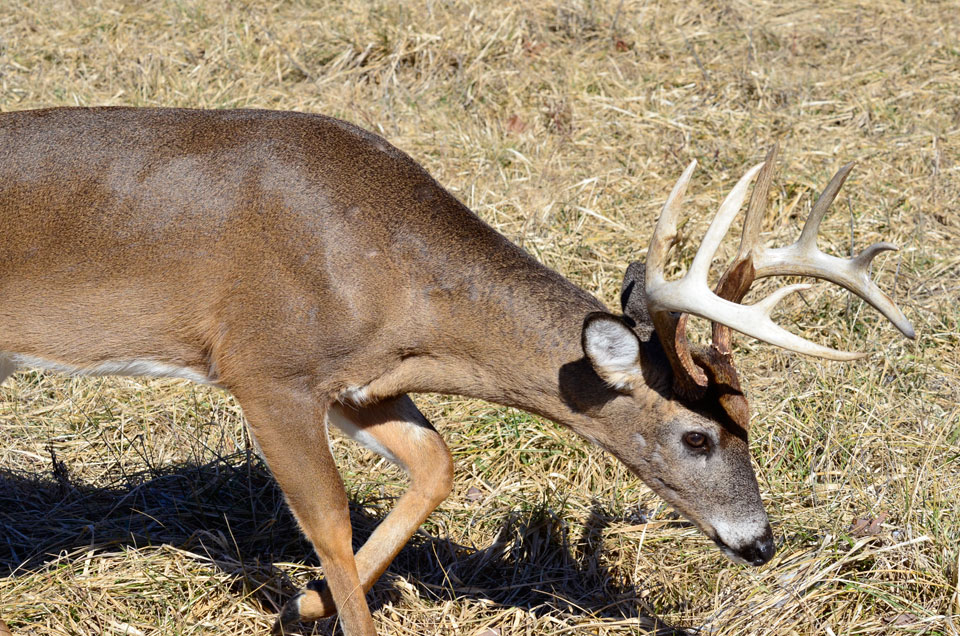
In 2016, I went to Kansas and harvested a nice 10-pointer. Although he was a 10-pointer, he only scored 134 points. I’d set up at a small pinch point where the only tree that was big enough to hold my tree stand and myself only was about 4 inches in diameter. A small clearing was in front of me on this, the last morning of the hunt. I knew a cold, bad-weather front was headed our way, and frost was on the ground as I went to my stand. I started rattling and grunting to create some excitement and hopefully bring in a buck.
When I looked out the corner of my eye, I spotted this 10-pointer coming across the opening. I started shaking, which made the leaves fall off the tree where I was. I was more concerned about the buck hearing all the leaves falling off the tree than I was with his smelling or hearing me. One of the things that had me so upset was I knew if the buck kept coming in the direction he was, he’d pass about 10 yards in front of me. The first thing I do when I get into a tree stand anywhere is range all the trees I think a deer may pass in front of me.
This buck was at about 75-80 yards on the left side of my tree when he came out of the woods. The site where I was in an open forest opened up into a CRP field. This hunt was a self-guided hunt, so I had to find and put up my tree stand where I thought my hunting would be the most productive. I’d located a bunch of scrapes and rubs around the spot where I set up. I always preferred to set up where I could see a good distance from my stand. I had considered setting up my deer decoy on the edge of the field. To be honest, I’d only hunted with a decoy in Kansas once before, but this trip was so short, I just left my deer decoy in the truck. Of course, then I learned that a deer decoy couldn’t do me much good if it was in the truck.
When the buck was about 30 yards away, I was still shaking so hard that I knew I wouldn’t be able to shoot accurately. I looked away from the deer, started taking deep breaths and told myself, “Calm down, Nate.” When the buck was at 15 yards, I turned and looked at him. The buck was steady walking, coming to me, not stopping for anything. Once the buck presented a broadside shot at 10 yards, I mouth bleated. He stopped and brought his head up. I released my arrow. I was surprised when the arrow struck further back some from where I’d been aiming. However, I must admit, I was nervous and shaky when I took the shot.
The buck kicked up and took off running with his tail down. Once he reached the woods, I was fairly certain I heard him crash. But because I didn’t see him fall, I decided that the best thing for me to do was stay in my tree stand and wait 1-1/2 hours before I went to look for him. Another reason I remained in the tree was because my father was hunting about 300 yards from me, and I didn’t want to ruin his hunt by getting down from my tree. He still had a tag and could take a buck, if he saw one.
The place in Kansas where we were hunting was leased by a friend of mine from New York. I sent my father a text as soon as I shot the buck. He texted me back, “Great shot, bud. I’ll be right over.” I answered, “No, we’re hunting in Kansas. You wait. I’ll text you back when I come down from my tree.”
My dad had seen a couple of small bucks that he didn’t choose to shoot. But at 9:50 a.m., he couldn’t stand waiting any longer, and he appeared at the bottom of my tree stand. By then I’d calmed down enough to climb down the tree. Dad and I walked to the spot where I’d shot the buck, however, we didn’t find my arrow. Evidently the arrow had not made a clean pass-through. I couldn’t believe that at that close a range, I didn’t have a clean pass-through. So, Dad and I got on the blood trail that went about 75 yards. We had no trouble then finding my buck.
Generally, I go out West once a year to hunt, but I wasn’t able to go in 2018. That’s why my buddy offered to take me to Kansas in the Midwest. From this hunt I learned that the best thing for me to do once I saw a nice buck coming was to look away from the deer, take some deep breaths and get myself together to make the shot when the buck came into range. This technique might not work for everyone, but it did for me.
















